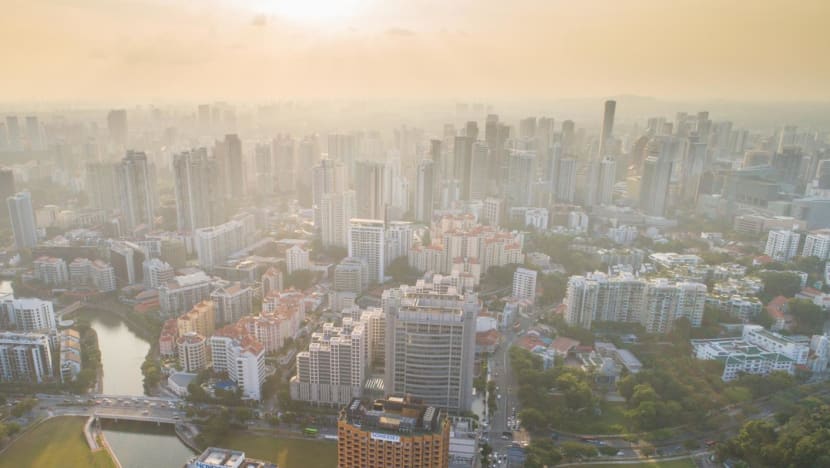From predicting floods to saving forests: 'Pivotal' role of AI in tackling 'most pressing' climate challenges
As the clock ticks on climate change, some organisations are pushing for artificial intelligence to break new ground from predicting disasters to protecting food security. Experts tell CNA about the myriad ways AI can help in our race against time.

Singapore's city skyline. (File photo: iStock)
SINGAPORE: With the meteoric rise of artificial intelligence, companies are tapping on one behemoth to tackle another beast – climate change.
While AI may have entered everyday usage with generative AI like ChatGPT, the sustainability space is no stranger to its benefits, such as predicting extreme weather events or climate-related disasters by analysing data.
But the clock is ticking on climate change.
According to the World Meteorological Organization in May, global temperatures are – for the first time – likely to break 1.5 degrees Celsius of warming within the next five years. This threshold signifies the point of no return where the worst effects of climate change would become irreversible.
Singapore, too, has felt the impact of climate change. In May, the country again hit its record high of 37 degrees Celsius, which was last experienced in 1983, and is set to experience days with peak temperatures of 40 degrees Celsius as early as 2045.
With time running out, some companies are hoping the latest wave of the digital revolution will eventually turn the tide.
URBAN SETTING
As smart cities emerge, AI can be “pivotal” in informing national decision-makers on the most pressing climate challenges, Google’s chief sustainability officer Kate Brandt told CNA.
“Through my interactions with many governments and policymakers worldwide, many have shared that they’re seeking innovative localised solutions to climate change that can be deployed in their countries and regions,” she said.
“However, a common challenge is the lack of tools to effectively harness complex data, which is required to develop new insights and plans of action.”
For starters, there are two main aspects of tackling climate change: Mitigation and adaptation, said director of the Agency for Science, Technology and Research’s (A*STAR) Centre for Frontier AI Research, Professor Ivor Tsang.
Mitigation involves reducing the extent of emissions and preventing further climate change, while adaptation is about responding to the existing effects of climate change.
In an urban setting, AI can address both these areas by enhancing complex systems, such as microgrids or buildings, to “make them more energy-efficient and/or be more robust to climate change”, said Prof Tsang.
It can also “accelerate the design and development of relevant technology and capabilities”.
Addressing AI's growing carbon footprint
Despite AI being largely seen as a positive development in tackling climate change, its carbon footprint in training and deployment phases are of growing concern within the community. Recent advances in AI have been driven by massive amounts of computing.
One way to address the issue during the training phase, said Prof Tsang, is to reduce the amount of data required. Select “only the most relevant data” to reduce energy cost or “efficiently adapt” existing models, for instance.
In the deployment phase, researchers can develop models or hardware that still perform well by consuming “very little power”.
Meanwhile, Google’s data centre cooling system, including in Singapore, relies on recycled water. It is, on average, more than one-and-a-half times as energy efficient as a “typical” enterprise data centre, according to Ms Brandt.
But as AI is at "an inflection point", predicting the future growth of energy use and emissions from data centres is "challenging", she said.
While research has shown an increase in demand for AI and machine learning, the energy needed to power this technology has increased at "a much slower rate than many forecasts predicted".
At A*STAR, for example, AI is incorporated into its work for engineering design, including for “new, performant materials” that are “critical to green chemistry and catalysis and/or renewable energy”, explained Prof Tsang.
These methods can be used to “develop methods or catalytic materials for carbon capture and utilisation”.
In a green energy-based future, the energy mix will be “much more complex”, including wind and solar. It can also be "intermittent", depending on factors such as the changing weather, he noted.
“Hence, AI is being used in the development of energy storage solutions such as batteries for facilitating this transition towards electrification and green energy for a decentralised grid of the future,” he said.
“Similarly, better forecasting of the availability of intermittent renewable energy such as solar, and the optimisation of these systems can allow us to move towards a net-zero future.”
AI can also be used in “greening building operations”, added Prof Tsang, pointing to “energy-hungry” data centres.
AI can improve designs to maximise ventilation and reduce the need for cooling, such as via air-conditioning, even in an “increasingly warming climate”. In turn, these AI models can serve as predictive models for “digital twinning”, enabling greener and more energy-efficient operations.
At the consumer level, Google’s Ms Brandt shared that AI is helping to recommend the best charging stops for electric vehicle users in Singapore on Google Maps. These suggestions are based on factors like current traffic situation, charge level and expected energy consumption.
DISASTER PREVENTION
In the broader Southeast Asia region, which can be more prone to extreme weather events, AI can also be used for disaster prediction and prevention.
With haze being a recurrent transboundary air pollution issue in the region, AI-driven air quality monitoring systems can provide real-time data on air pollution levels, which can “provide warning to the public and drive public agency decision-making to improve air quality and reduce emissions”, said Prof Tsang.
AI can also improve the accuracy of weather forecasting models, allowing for “more reliable predictions” of extreme weather events, such as typhoons, heavy rainfall and flooding, he added.
Pointing to how sea levels are rising faster in Southeast Asia than any other part of the world, as well as how countries in the region “fall victim to many climate hazards” due to low-lying countries, Ms Brandt said that Google’s AI can help communities through hyperlocal flood forecasting models that predict where riverine floods will occur.
“This way, we are able to alert people in areas that will be impacted, up to seven days in advance before disaster strikes. We can also share information on where they can go to be safe,” she added.
“This is integral because accurate and accessible forecasting has the potential to decrease fatalities and economic damages by 30 to 50 per cent.”
Developing countries at the United Nations COP27 climate summit last year proposed a climate "loss and damage" fund to unlock at least US$100 billion by 2030 to address irreversible damage caused by climate change.
While countries agreed to the fund, no decision has yet been made on which countries will bear the cost and which will benefit. But some have argued that rich countries contribute the most to climate change and owe a debt to poorer ones who are least responsible yet suffer the most.
In the meantime, individual organisations of all sizes can also contribute to climate change, Ms Brandt believes.
On one hand, small companies have an "integral role" to play in tackling climate change, especially with their "hyperlocal insights" and "on-the-ground experience". Instead of taking the wheel, larger companies can then support smaller organisations who require monetary or technical support to realise their solutions and help them scale, she added.
Google.org, the tech giant's philanthropic arm, committed US$1 million to Singapore's Mandai Nature last year as part of its efforts to combat climate change.
On Thursday (Sep 28), it announced its continued commitment to AVPN's APAC Sustainability Seed Fund with a funding grant of another US$5 million, bringing its total support to US$8 million over two years.
Listen: One farmer talks about growing her crops in a climate-stressed world
FOOD SECURITY
Nonetheless, as such extreme weather affects the food we put on our table, AI can step in to help the agriculture industry adapt to climate change so their practices don’t become obsolete, noted Prof Tsang.
“Modern agribusinesses can use AI to analyse their farms’ data for crop yield predictions or climate control, especially in the face of climate change. Specific to Singapore, AI can assist businesses in becoming more efficient, especially in the face of land and manpower constraints,” he explained.
For example, A*STAR’s partnership with Archisen, an agri-tech firm based in Singapore, helped the firm to produce up to 100 tonnes of vegetables annually, by using AI to create a predictive model that determined key parameters affecting yield and quality.
On the other side of the world, Mr Eric Enno Tamm, CEO and co-founder of This Fish, a Vancouver-based software and AI company for the seafood industry, has seen how warmer ocean conditions have created algae blooms, resulting in “large aquaculture die-offs”.
He added that sockeye salmon – the “very red, high-quality sushi salmon” often found in sushi restaurants – being produced out of British Columbia has also "gone down considerably” in the last 20 years.
Even though one might assume AI can help fishermen predict future fishing patterns, Mr Enno Tamm, whose firm has a couple of customers in Singapore, highlighted that climate change might ironically impede this development.
He recalled a conversation with tuna fishermen from the Philippines about whether digitising about 20 years of their logbook data, on where they caught their fish and the past weather conditions, would help them to predict which would be the best areas to fish for the future.
“The one thing they said that was interesting is that because climate change has been changing patterns, where the stocks are and (the fish) migrations, they felt that actually all of that historic fishing data may not help them understand where to catch fish in the future,” he said.
“In this case, climate change is actually jamming AI. Most machine learning uses historical data to predict the future. But if we fundamentally change the environmental regime … then actually your historical data is not going to help you that much for the future.”
Still, Mr Enno Tamm added, AI can help fish farmers “at a microscale”, such as understanding how changing ocean conditions today would affect the behaviour of their fish over the next month.
“The biggest impacts, I think, from climate change are going to be on the ocean. Because we’re not aquatic animals, we’re not going to see it as quickly. But we’ll see it in our food," he said.
AI IN "NATURE-BASED" SOLUTIONS
Over at the Centre for Nature-based Climate Solutions (CNCS) at the National University of Singapore, research has taken on a slightly different slant. The centre focuses on tackling climate change with nature.
“While climate change is a major crisis confronting humanity today, another crisis is looming – biodiversity loss. Nature-based solutions can help our efforts in tackling them both,” the centre’s director, Professor Koh Lian Pin, told CNA.
Using the example of saving forests, Prof Koh said ensuring forests remain intact not only prevents the release of greenhouse gas emissions associated with deforestation. Forests are also home to wildlife, and deliver water purification to local communities.
Still, there are “some uncertainties” involved in quantifying the role of nature, he noted. “Most estimates on natural carbon storage by forests in Southeast Asia are done using global or pantropical models – a one-size-fits-all approach.”
As such, CNCS last year launched the Carbon Integrity research project, which aims to develop models specific to Southeast Asia by leveraging AI.
CNCS works with partners to establish “forest monitoring plots” where carbon estimates are made using tree measurements taken during field surveys, Prof Koh explained.
Then, a drone- or airplane-mounted Light Detection and Ranging (LiDAR) sensor is used to scan the forest plots and collect data. This data includes the density of canopy cover and the varying heights of trees, and can also be used to observe the forest structure at a larger spatial scale.
This data, together with information on land cover from satellites, supplements carbon estimates derived from field measurements.
To estimate the amount of carbon in different forest types, researchers then bring in machine learning – a subset of AI that recognises patterns in large data sets – to identify relationships between the data sets and develop models combining field measurements, LiDAR data and satellite data.
The end goal? Having these models estimate carbon in the future using “only the satellite data”, said Prof Koh.
Having models of specific forest types will provide "more accurate estimates" of carbon storage in Southeast Asia’s forests and natural habitats, he added.
And this could then help policymakers "prioritise areas for conservation or give land developers greater confidence to protect forests as forest carbon projects, instead of felling them for other land uses".




















